View in other NatureServe Network Field Guides
NatureServe
Montana
Utah
Wyoming
Idaho
Wisconsin
British Columbia
South Carolina
Yukon
California
New York
Large-flower Fleabane - Erigeron grandiflorus
Other Names:
Erigeron simplex
Native Species
Global Rank:
GNR
State Rank:
S4
(see State Rank Reason below)State Threat Score:
Unknown
C-value:
Agency Status
USFWS:
USFS:
BLM:
External Links
State Rank Reason (see State Rank above)
Erigeron grandiflorus and Erigeron simplex were previously differentiated based on the size of the corolla disk, number of pappus bristles, and number of homologous chromosome sets (ploidy) (Lesica et al. 2012). Erigeron grandiflorus was recognized as being triploid while Erigeron simplex was recognized as being diploid by S.A. Spongberg (1971) (Nesom in Flora of North America (FNA)). However, the morphology associated with these ploidal races does not appear to be consistent across the range of either species (Nesom in FNA). In FNA, Guy Nesom treats Erigeron grandiflorus and Erigeron simplex as synomyms, accepting the older name of Erigeron grandiflorus (Nesom in FNA 2006). Under the older concept, Erigeron simplex was found in alpine habitats through much of western and central Montana while Erigeron grandiflorus was found in alpine habitats of Carbon and Sweet Grass counties (Lesica et al. 2012). The MTNHP accepted the concept developed by Nesom (in FNA 2006); therefore, these species are considered synonyms and together are ranked as 'apparently secure' in Montana.
- Details on Status Ranking and Review
Range Extent
ScoreF - 20,000-200,000 sq km (~8,000-80,000 sq mi)
CommentAt least 68 observations occur within an approximate 83,071 sq km range extent.
Area of Occupancy
ScoreE - 26-125 4-km2 grid cells
CommentMontana can be divided into 30,390 4x4 square kilometer cells. For this species plant observations occur in at least 56 of these 4x4 square kilometer cells.
Number of Populations
ScoreD - 81 - 300
CommentBetween 68 and 161 observations of Erigeron grandiflorus have been documented by the MTNHP database and CPNWH portal.
Environmental Specificity
ScoreC - Moderate. Generalist or community with some key requirements scarce
CommentPlants grow in the alpine, which is generally common in Montana.
Threats
CommentNo threats have been reported.
General Description
PLANTS: Perennial with a simple caudex, fibrous-rooted caudex, or crown-like rhizomes; rhizes may be relatively short and thick. Plants grow erect or ascend, 2-25 cm tall. Plants are sparsely to moderately pilose to nearly villous-hirsute and often have stalked glands (stipitate-glandular). Source: Nesom in FNA 2006; Lesica et al. 2012.
LEAVES: Basal leaves are persistent. Cauline leaves are alternately arranged. Leaf petioles are shorter than the blade. Leaf blades are oblanceolate to obovate or spatulate in shape, 10-60(-90)mm long by 3-8(-14)mm wide, and sparsely tangled-villous; often minutely glandular. Leaf margins are smooth (entire) and leaf tips are rounded. Sources: Nesom in FNA 2006; Lesica et al. 2012.
INFLORESCENCE: Flowers are arranged with heads. The involucres are 5-12 mm high. Ray florets are 50-130 in number, blue to pink to purplish, rarely white, and ray petals are 7-11(-15) long and 1-2 mm wide. Disk florets are 2.4-4(-5) mm tall. The pappus consists of an outer set of setae and an inner set of (7-)10-18(-22) bristles. Fruit is an achene. Sources: Nesom in FNA 2006; Lesica et al. 2012.
Phenology
Plants flower from July through August or September (Nesom in FNA 2006).
Species Range
Montana Range
Range Descriptions
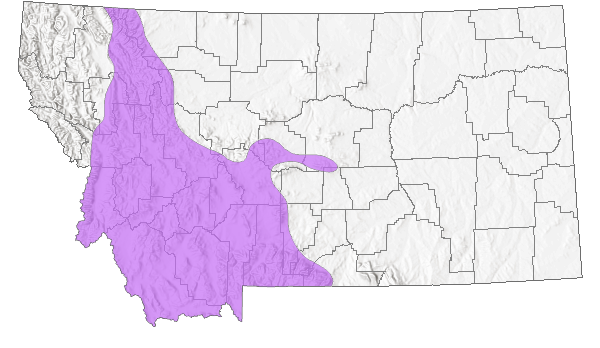
 Native
Native
Range Comments
In Canada plants occur in Alberta and British Columbia provinces (Nesom in FNA 2006). In the USA, plant occur in Montana, Idaho, Oregon, Wyoming, Colorado, Utah, New Mexico, and Arizona (Nesom in FNA 2006).
Observations in Montana Natural Heritage Program Database
Number of Observations: 79
(Click on the following maps and charts to see full sized version)
Map Help and Descriptions
Relative Density
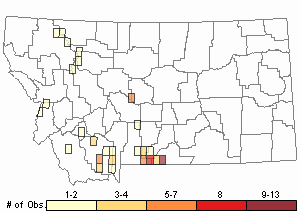
Recency
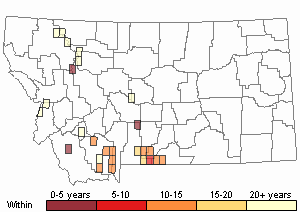
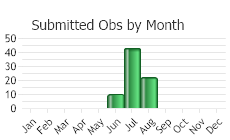
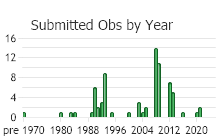
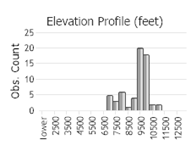 (Observations spanning multiple months or years are excluded from time charts)
(Observations spanning multiple months or years are excluded from time charts)
Habitat
Rocky sites, meadows, and moist fell fields in the alpine or near timberline (Nesom in FNA 2006; Lesica et al. 2012).
National Vegetation Classification System Groups Associated with this Species
Alpine
Alpine - Sparse and Barren
Alpine - Vegetated
Ecology
POLLINATORS The following animal species have been reported as pollinators of this plant species or its genus where their geographic ranges overlap:
Bombus bifarius,
Bombus centralis,
Bombus fervidus,
Bombus flavifrons,
Bombus huntii,
Bombus melanopygus,
Bombus mixtus,
Bombus rufocinctus,
Bombus occidentalis, and
Bombus insularis (Thorp et al. 1983, Wilson et al. 2010, Colla and Dumesh 2010, Koch et al. 2012).
Reproductive Characteristics
FRUIT
Fruit is an achene. The cypselae is 1.8-2.4 mm long, 2-nerved, and strigose on the face (Nesom in FNA 2006).
Stewardship Responsibility
Threats or Limiting Factors
There are no known threats (MTNHP Threat Assessment 2021).
References
- Literature Cited AboveLegend:
 View Online Publication
View Online Publication Colla, S.R. and S. Dumesh. 2010. The bumble bees of southern Ontario: notes on natural history and distribution. Journal of the Entomological Society of Ontario 141:39-68.
Colla, S.R. and S. Dumesh. 2010. The bumble bees of southern Ontario: notes on natural history and distribution. Journal of the Entomological Society of Ontario 141:39-68. Koch, J., J. Strange, and P. Williams. 2012. Bumble bees of the western United States. Washington, DC: USDA Forest Service, Pollinator Partnership. 143 p.
Koch, J., J. Strange, and P. Williams. 2012. Bumble bees of the western United States. Washington, DC: USDA Forest Service, Pollinator Partnership. 143 p. Lesica, P., M.T. Lavin, and P.F. Stickney. 2012. Manual of Montana Vascular Plants. Fort Worth, TX: BRIT Press. viii + 771 p.
Lesica, P., M.T. Lavin, and P.F. Stickney. 2012. Manual of Montana Vascular Plants. Fort Worth, TX: BRIT Press. viii + 771 p. Spongberg, S.A. 1971. A systematic and evolutionary study of North American arctic and alpine monocephalous species of Erigeron (Compositae). PhD dissertation
Spongberg, S.A. 1971. A systematic and evolutionary study of North American arctic and alpine monocephalous species of Erigeron (Compositae). PhD dissertation Thorp, R.W., D.S. Horning, and L.L. Dunning. 1983. Bumble bees and cuckoo bumble bees of California (Hymenoptera: Apidae). Bulletin of the California Insect Survey 23:1-79.
Thorp, R.W., D.S. Horning, and L.L. Dunning. 1983. Bumble bees and cuckoo bumble bees of California (Hymenoptera: Apidae). Bulletin of the California Insect Survey 23:1-79. Wilson, J.S., L.E. Wilson, L.D. Loftis, and T. Griswold. 2010. The montane bee fauna of north central Washington, USA, with floral associations. Western North American Naturalist 70(2): 198-207.
Wilson, J.S., L.E. Wilson, L.D. Loftis, and T. Griswold. 2010. The montane bee fauna of north central Washington, USA, with floral associations. Western North American Naturalist 70(2): 198-207.
- Additional ReferencesLegend:
 View Online Publication
View Online Publication
Do you know of a citation we're missing? Aho, Ken Andrew. 2006. Alpine and Cliff Ecosystems in the North-Central Rocky Mountains. Ph.D. Dissertation. Bozeman, Montana: Montana State University. 343 p.
Aho, Ken Andrew. 2006. Alpine and Cliff Ecosystems in the North-Central Rocky Mountains. Ph.D. Dissertation. Bozeman, Montana: Montana State University. 343 p. Flora of North America Editorial Committee. 2006. Flora of North America North of Mexico. Vol. 20. Magnoliophyta: Asteridae, part 7: Asteraceae, part 2. Oxford Univ. Press, New York. xxii + 666 pp.
Flora of North America Editorial Committee. 2006. Flora of North America North of Mexico. Vol. 20. Magnoliophyta: Asteridae, part 7: Asteraceae, part 2. Oxford Univ. Press, New York. xxii + 666 pp. Hawkins, P.H. 1903. The alpine flora of Montana. M.Sc. Thesis, Bozeman, MT: Montana State University. 24 pp.
Hawkins, P.H. 1903. The alpine flora of Montana. M.Sc. Thesis, Bozeman, MT: Montana State University. 24 pp. Jones, W. W. 1901. Preliminary flora of Gallatin County. M.S. Thesis. Bozeman, MT: Montana State College. 78 pp.
Jones, W. W. 1901. Preliminary flora of Gallatin County. M.S. Thesis. Bozeman, MT: Montana State College. 78 pp. Kerstetter, T.A. 1994. Taxonomic investigation of Erigeron lackschewitzii. M.Sc. Thesis. Bozeman, MT: Montana State University. 90 p.
Kerstetter, T.A. 1994. Taxonomic investigation of Erigeron lackschewitzii. M.Sc. Thesis. Bozeman, MT: Montana State University. 90 p. Lesica, P., M.T. Lavin, and P.F. Stickney. 2022. Manual of Montana Vascular Plants, Second Edition. Fort Worth, TX: BRIT Press. viii + 779 p.
Lesica, P., M.T. Lavin, and P.F. Stickney. 2022. Manual of Montana Vascular Plants, Second Edition. Fort Worth, TX: BRIT Press. viii + 779 p. Martin, S.A. 1985. Ecology of the Rock Creek bighorn sheep herd, Beartooth Mountains, Montana. M.Sc. Thesis. Bozeman, MT: Montana State University. 152 p.
Martin, S.A. 1985. Ecology of the Rock Creek bighorn sheep herd, Beartooth Mountains, Montana. M.Sc. Thesis. Bozeman, MT: Montana State University. 152 p. Pallister, G.L. 1974. The seasonal distribution and range use of bighorn sheep in the Beartooth Mountains, with special reference to the West Rosebud and Stillwater herds. M.Sc. Thesis. Bozeman, MT: Montana State University. 67 p.
Pallister, G.L. 1974. The seasonal distribution and range use of bighorn sheep in the Beartooth Mountains, with special reference to the West Rosebud and Stillwater herds. M.Sc. Thesis. Bozeman, MT: Montana State University. 67 p. Saunders, J.K. Jr. 1955. Food habits and range use of the Rocky Mountain goat in the Crazy Mountains, Montana. Journal of Wildlife Management 19(4):429-437.
Saunders, J.K. Jr. 1955. Food habits and range use of the Rocky Mountain goat in the Crazy Mountains, Montana. Journal of Wildlife Management 19(4):429-437. Saunders, J.K., Jr. 1954. A two-year investigation of the food habits and range use of the Rocky Mountain goat in the Crazy Mountains, Montana. M.Sc. Thesis. Bozeman, MT: Montana State University. 22 p.
Saunders, J.K., Jr. 1954. A two-year investigation of the food habits and range use of the Rocky Mountain goat in the Crazy Mountains, Montana. M.Sc. Thesis. Bozeman, MT: Montana State University. 22 p. Simanonok, M.P., and L.A. Burkle. 2014. Partitioning interaction turnover among alpine pollination networks: Spatial temporal, and environmental patterns. Ecosphere 5(11):149.
Simanonok, M.P., and L.A. Burkle. 2014. Partitioning interaction turnover among alpine pollination networks: Spatial temporal, and environmental patterns. Ecosphere 5(11):149. Williams, K.L. 2012. Classification of the grasslands, shrublands, woodlands, forests and alpine vegetation associations of the Custer National Forest portion of the Beartooth Mountains in southcentral Montana. M.Sc. Thesis. Bozeman, MT: Montana State University. 376 p.
Williams, K.L. 2012. Classification of the grasslands, shrublands, woodlands, forests and alpine vegetation associations of the Custer National Forest portion of the Beartooth Mountains in southcentral Montana. M.Sc. Thesis. Bozeman, MT: Montana State University. 376 p.
- Web Search Engines for Articles on "Large-flower Fleabane"





